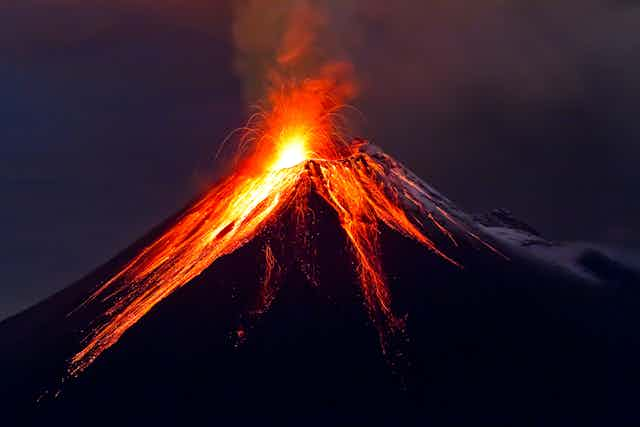We started 2016 with a bang. Both Chile and Indonesia saw a clutch of volcanoes erupting after laying dormant for a decade or more. This followed an eruption in April 2015, when Calbuco volcano in Chile burst back to life after more than 40 years of silence, with experts giving less than two hours of warning. In an era of global satellite monitoring with proliferating networks of instruments on the ground, why can we still not accurately predict volcanic eruptions?
Volcano scientists have an unprecedented array of tools with which to keep an eye on the world’s many restless and active volcanoes. In many cases, we can watch emerging events from the safe distance of an volcano observatory. Or, once an eruption has begun, we can observe it in near-real time using satellite feeds and social media. But this isn’t matched by our ability to anticipate what might happen next at a restless but dormant volcano. New research, however, is providing clues about the best way to look for signals of future volcanic behaviour.
Like medicine, volcanologists can get a clearer sense of the state of a volcano using observations from many other examples around the world. But if we don’t know the prior history of a particular volcano, and with no way of taking the equivalent of a biopsy from it, our capacity to work out what is going on is always going to be limited. For example, some volcanoes stay completely quiet and then erupt violently without warning, while others are noisy but have a moment of calm before they erupt. Without prior knowledge, how would we know?

Sampling eruptions
While we can’t yet safely drill into a rumbling volcano, the deposits from past eruptions may contain the information we need about what happened in the build-up to that eruption. Explosive eruptions typically throw out large quantities of ejecta, the frozen and disrupted remnants of the emptied magma reservoir.
This often includes pumice, a light and frothy rock made of a network of glassy tubes, sheets and strands and a void space that fills with volcanic gas, mainly steam, just before eruption which is then replaced with air. Other components include crystals of different minerals that grew at depth as the magma cooled and started to solidify, perhaps for decades or centuries.
Explosive eruptions are thought to be caused by bubbles of gas escaping from the molten rock deep below the ground. When fresh magma first arrives beneath the volcano, it usually contains quantities of dissolved gases, like water and carbon dioxide.
As the magma cools and freezes into solid rock, the gases remain dissolved in a smaller and smaller amount of melt, until eventually the melt becomes saturated and bubbles of gas start to form. From this point, the pressure inside the volcano begins to build and eventually, the rocks around the magma chamber crack. Then the bubbly magma rises through the crack to the surface, starting an eruption.

Bubbles point the way
But how can we find out the point at which the magma starts to grow bubbles? This is where forensic volcanology comes in. As magmas freeze, the crystals formed at different times will capture snapshots of the state of the reservoir. With some good fortune, it is sometime possible to go and find these crystals after an eruption, and piece together the sequence of events.
In our new research, my colleagues and I have shown how this approach works at Campi Flegrei, a steaming volcanic field that lies west of Naples and the supposed location of the entrance to the underworld in Roman mythology. By analysing the composition of one particular mineral called apatite, which grew throughout the long cooling history of the magma, we found that the gas bubbles could only have formed shortly – perhaps a few days to months – before the eruption itself. So at this volcano, the best signals of an impending eruption might be a combination of swelling of the ground levels (with changing pressure) and in the gases escaping out of the volcano.
This still doesn’t provide us with a simple way to predict the eruptions of any volcano. But it does show how taking a forensic look at the deposits of past eruptions at a specific site offer a way to help identify the monitoring signals that will give us clues to future behaviour. And this moves us a step closer to being able predict when an eruption is likely.

